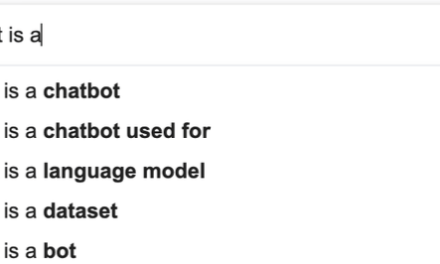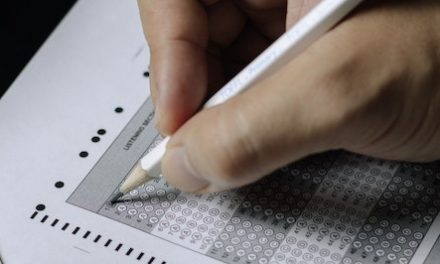Supervised by: Ujjayanta Bhaumik MSC, B.Tech (Hons). Ujjayanta Bhaumik is currently pursuing his PhD in Computer Science and Physics with a focus on Virtual Reality in the Light and Lighting Lab, KU Leuven. He worked as a creative software developer for over 2 years. He has a masters in Computer Graphics, Vision and Imaging from University College London.
Abstract
Chatbots are completely revolutionizing today’s world. Whether for medicine, education, corporate, or customer service, chatbots have vastly changed every industry. These areas are integrating chatbots into their daily human interactions more and more every day. This article analyzes how chatbots are used today in these sectors of society and what their future can be. The possibilities are shown to be endless. Firstly, the healthcare industry has made wide use of the variety of possibilities chatbots provide: they started by simply providing assistance to a healthcare worker and are now starting to take on the full role of a doctor and working with patients. Chatbots are still a work in progress in the education field; some studies and experiments have been done which have shown positive results. Chatbots save time in the classroom and give students a unique experience. In the corporate side of society, chatbots have been used by many companies to facilitate client interactions and help people with complicated tasks. Many CEOs of companies like this predict that chatbots and AI will serve the majority of society in the future. Chatbots have also found applications in customer service, where AI has allowed for more useful and helpful chat assistants. This is increasingly being used to replace traditional human customer support to increase efficiency and reduce costs, but this does have some limitations and ethical issues. AI and Chatbots are evolving to become something big in the future.
Introduction
Chatbots and Artificial Intelligence are going to be of the essence in the future, and some might not know it yet. It is evolving faster than one might think, and soon it is going to be part of the everyday lifestyle like the smartphone once evolved to be. Being informed about chatbots and knowing how to take advantage of them is a crucial step into the future.
The very first chatbot ever was called ELIZA, developed by MIT professor Joseph Weizenbaum in 1966. ELIZA was essentially a therapist; however, this was just a rule-based chatbot. This means that it is a “system that analyzes input and responses by rules” and “simply rephrased input back to the human”, typically in the form of a question. ELIZA asks for input,, and based on pre-written answers;; the corresponding answer is outputted. This was made to make the person writing the questions feel as if there was someone who understood them.
However, what if there was a chatbot that could theoretically understand them? This is what exactly many are trying to do currently. Today, there are a few Artificial Intelligence chatbots that use Natural Language Processing and other software innovations to allow computers to understand the text and spoken words like humans. With Artificial Intelligence chatbots, the computer learns and is trained to give more accurate answers based on a conversation between the human and the computer. Some examples of recently developed AI chatbots are Cleverbbot, Freshcchat, and Ada. Using this chatbot, however, has been proven to be malfunctioning at times and complicated to understand for the user. In Figure 1.0, this can be observed as a user attempts to communicate with a popular chatbot like Cleverbbot and struggles to maintain a meaningful conversation.
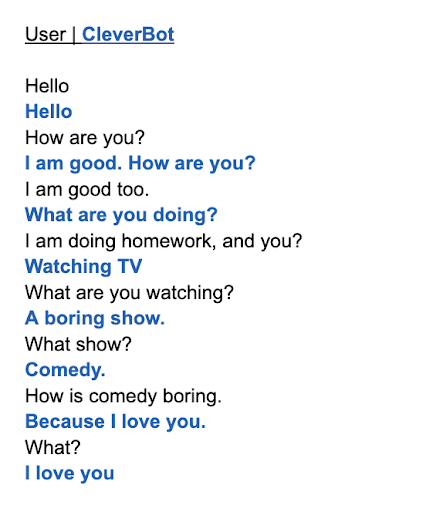
Figure 1.0: CleverBot
This chatbot is proof of the large margin for future improvement and development.
Background
Most chatbots seen today use artificial intelligence (AI) and natural language processing (NLP) technologies to identify sentence structure, understand information and increase their capacity to answer inquiries.
Instead of having to be programmed beforehand with answers to each possible corresponding question, like rule-based chatbots, AI chatbots first determine what the consumer or user is saying. After determining what the user is searching for, the chatbot offers an answer that it feels is correct based on the available knowledge that was given. Through machine learning, the system “learns” the correct responses over time by examining past correct and incorrect responses.
1. Chatbots in Medicine
Chatbots appear in the future of a myriad of industries, one of the most prominent being the medicinal industry [5, 7]. For obvious reasons, healthcare is one of the world’s priorities. There are hundreds of diseases that remain incurable today, and chatbots can potentially be a vehicle for progress [12].
The medicinal field currently uses three types of chatbots:
- AI-based chatbots
- Rule-based chatbots
- Informative chatbots
This section will discuss how these chatbots are used and will be used to further medicinal progress and aid current doctors in their work [15, 19].
1.1 General Health
In general medicine, chatbots are used to:
- Schedule medical appointments.
- Provide any medical information concerning treatments, prescriptions, details of symptoms, etc.
- Provide information or answers to questions regarding insurance.
- Collect and analyze patient data according to previously stored data on the specific patient.
- Provide mental health assistance.
- Request prescription refills.
1.2 Florence
Florence is a successful chatbot currently used by healthcare facilities as an online personal health assistant. Launched in 2017, Florence has been significantly helping the ill by making health information more accessible. The chatbot works on Facebook Messenger, Skype, or Kik and has improved to become an efficient and simple program to use. Florence provides: reminders for patients to take any necessary medication, specific information relating to any prompted medicine, illness, or disease (Figure 1.1), and tracks any user’s health according to their recorded body weight, mood,, or period. The chatbot can additionally be used as a search engine to locate nearby healthcare facilities [12].
1.3 Mental Health
What is keeping robots from being different from humans? They lack emotions and a conscience. However, in time, AI” will develop more similar capacities to humans and will be able to perform more advanced tasks. One very important outcome of this will be improvements in mental health [8]. People struggling with mental disorders and psychosis must be treated by a trained doctor. However, studies have shown that caring for such patients has drastic effects on the doctors” health [3]. This is where chatbots come in. What if a chatbot could analyze a patient”s emotions and reactions to certain events to use appropriate strategies and calm the patient down? This would greatly benefit all the doctors who face the pain of treating such unfortunate, delicate cases and leave no room for human error.
1.4 COVID-19
The recent pandemic has provided an immense amount of progress in chatbot technology. As a result of the mass outbreak, drastic measures were taken and had to be applied to the entire world. Chatbots allow for the multitasking of scientists:
- Chatbots could guide the ill to nearby, available healthcare facilities.
- Chatbots were constantly available to provide any information regarding accurate statistical analyzes of the pandemic and the most recent updates and answer any questions prompted by the users.
- Chatbots aided the mentally ill in need of coping due to stress caused by COVID-19.
1.5 Future
What might one expect in the healthcare industry from chatbots? Naturally, one cannot predict what the upcoming discoveries and progress will exactly look like. However, scientists” hopes for the future, as well as statistical predictions, can be expressed.
- Chatbots are expected to make up a market size of more than $1 billion.[5]
- Future uses:
- Providing constant, around-the-clock companionship.
- Real-time health monitoring.
- Making automatic emergency calls.
- Managing chronic conditions, mental health issues, and behavioral and psychological disorders.
- Identifying symptoms, cross-checking them against medical history, and providing immediate solutions and care.
- Becoming virtual care assistants by providing timely medical advice.
2. Chatbots in Education
Chatbots have a high potential to improve the quality of education immensely. In many universities, there is an overload of students and a lack of professors/teachers to educate them. Therefore, lecturers are forced to teach their lessons to a general audience. This makes the learning experience worse due to the lack of personalized support to the students from the lecturer. Chatbots are a great solution to this because they would be able to assist all the students simultaneously [11]. The use of chatbots in classrooms and study halls is on the rise; however, they are still not being implemented on a large-scale [16].
2.1 Juji
One chatbot that is useful for schools and online education is Juji. Juji allows educators to launch a chatbot without any coding. It is flexible as it works for school teachers, online courses, and university lecturers. There are different template bots that have different functionalities. Some of them are to answer general questions, answer questions about a task and ask about online courses. Tools like Juji allow educators to handle larger groups of students during a class. If students need to ask small and simple questions, they can ask the chatbot instead of the teacher; the teacher can then focus their attention on students who require support on a more complex issue [17].
2.2 Application
Some studies have been done where chatbots were applied in learning environments. The University of Georgia made and used a chatbot to manage forum posts and queries of students in a computer science course. The feedback from the students was very positive; they felt more engaged and wanted to use chatbots in other courses too.
2.3 Functionalities
Chatbots have two main functionalities in education: question-and-answer (Q&A) and quizzes. The question-and-answer functionality is beneficial as it is high value for time since students receive immediate answers. However, the problem is that replies tend to be vague and may not be very effective. The quiz functionality is useful for students. Feedback from students that have used chatbots in a quiz format carried out by Linnaeus University was positive; the students felt that it was better than the traditional exam as it gave support and hints to them. However, some students felt that some teachers would not spend enough time developing the chatbot and quiz.
2.4 Limitations
There are limitations to this concept. At this moment, personalized and unique replies to students’ questions and comments cannot be achieved due to the lack of information and resources. However, based on the feedback from students in the experiment conducted by Linnaeus University, these personalized replies are not required to have a positive impact. Chatbots could still be used to acquire simple information and answers.
3. Chatbots in Corporate
Chatbots are currently revolutionizing the corporate part of society. This includes its job search and recruitment facets [4, 9].
3.1 Mya
In 2016, the company FirstJob introduced Mya, a chatbot used to recruit potential job applicants and find jobs for people.
After an application is submitted, Mya introduces herself and begins a conversation with the candidate, and pre-screens the candidate to see if they meet the qualifications. Mya then uses artificial intelligence (AI) and natural language processing (NLP) to answer any questions job applicants might have about the company, with insightful answers to try to recruit the applicant. The automated assistant then asks questions to verify qualifications or give the applicant better job options that correspond to the applicant’s prior experience and knowledge. Also, if the applicant is struggling to make a good impression on the company or meet certain qualifications, Mya gives tips and guidance to candidates.
When a candidate asks a question that Mya does not know the answer to, it is sent to a real person in the company to answer the question, save the question and answer to its database to learn from to answer it correctly next time. This process allows the AI assistant to improve constantly.
In the following image (Figure 3.1), Mya is making the applicant aware of their lack of qualifications and asks a follow-up question to get the best chances for his application to be accepted:
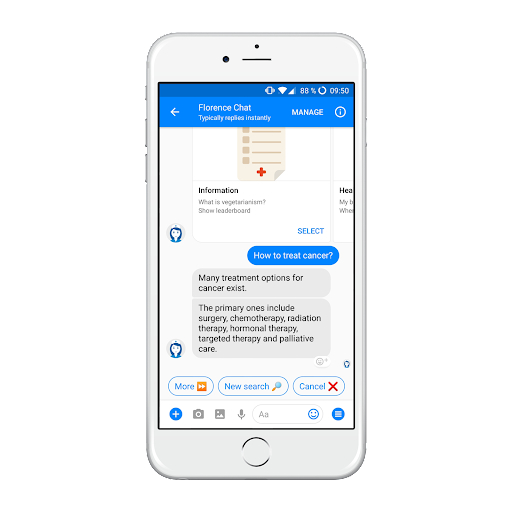
Figure 1.1: Florence chatbot.
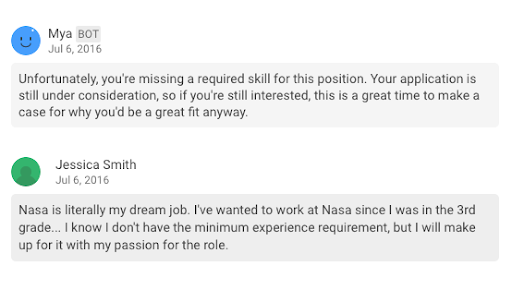
Figure 3.1: Working of Mya.
Mya also gives updates regarding the person’s application and connects the applicant to a real employee in the company to make the conclusions (Figure 3.2).
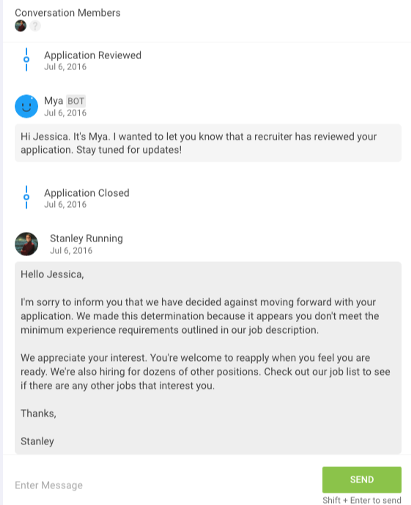
Figure 3.2: Working of Mya.
The company said Mya automated around 75% of the “qualifying and engagement process” [4]. In fact, the CEO of the company at the time, Eyal Grayevsky, said, “Right now, our goal was to create a fully-automated recruitment assistant. A recruiter must stay involved. Our long-term vision is to develop Mya into a fully automated recruiter”.
In 2021, Mya was acquired by StepStone, and Grayevsky went on to join that company as well. During this big step, the CEO of StepStone, Dr. Sebastian Dettmers, announced, “Today, online job search still relies on job-seekers typing in job titles and locations. As a result, many people do not find the right job. In the future, conversational AI will help us to have meaningful interactions with our users and to find out what matters to them. Our goal is to fundamentally change how job seekers discover their full range of opportunities” [14].
Today, Mya improves recruiter efficiency by around 60% and increases candidate engagement by over 150%. Also, now, Mya is used by companies to increase hires and by people to find jobs.
Mya started as a startup innovation and evolved to be “one of the most advanced conversational technologies, which is now used in recruitment processes all over the world” [14].
3.2 TARA
In the business world, getting hired for jobs is one thing, but building and managing a business is another. TARA (Talent Acquisition and Recruiting Automation) [1] automates hiring contractors and project management.
In the first year of TARA”s creation, 45 developers were hired to complete 60 projects for 50 companies [9, 10]. TARA allows anyone to create websites, virtual reality apps, logos, and company names easily through simple interactions between humans and AI.
To start, anyone can text TARA about what type of business they want to create, and TARA can ask questions regarding the business. AI and NLP are used to comprehend all the user’s needs to give proper responses. The following image is an example of what an interaction may look like (Figure 3.3):
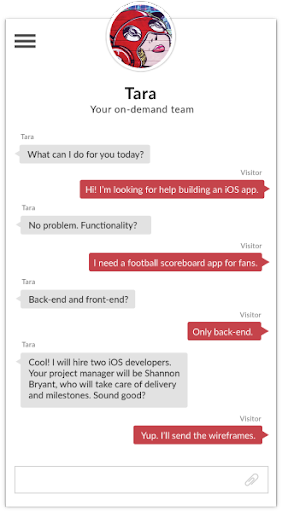
Figure 3.3 TARA Chatbot.
In the beginning, TARA was only able to hire contractors for a corresponding business idea. Near the beginning of its creation in 2016, the CEO of TARA, Iba Masood, said, “The bot personal assistant will be able to give project updates in the future…” 6 years later, today, her goal was accomplished, and TARA can now give constant updates on the activity of the company management.
Today, TARA also comes with a whole user interface for the user to check and manually do actions. It also allows the user to plan and track mission-critical product updates and gives insights instantly into where things are in the projects. TARA also helps with managing teams by allowing the user to automate simple tasks like status changes, recurring sprints, and effort predictions. All this can be done with a simple conversation with TARA, or you can set it automatically on the UI [1].
Masood also said that in the future, they want to apply their automated project approach to tackling large projects for governments or other industries. Therefore, we are expected to see TARA or TARA-like AI chatbots being used in the future for bigger projects.
On the user side, chatbots look so simple, but if seen from the other side, chatbots are more complex than anyone might imagine. Using artificial intelligence, natural language processing, and more, the whole corporate and business side of society changes immensely. With a few sentences, you can get a job, recruit employees, or even create your own business. The CEO of all these AI chatbot companies, like Mya and TARA,, have optimistic prospective goals for the future and where their projects can evolve.
4. Chatbots in Customer Service
4.1 Use in Customer Service
Chatbots and artificial intelligence are increasingly used to provide customer service by many companies, exchanging many aspects of traditional user interfaces or human chat services with automated conversational user interfaces. In particular, text-based chatbots for online web pages provide baseline support for customers seeking assistance or information. The ability of chatbots, using natural language processing, to allow customers to express what they need in their own words and automatically assist with that can greatly “improve efficiency and performance in companies’ service functions” [6].
4.2 Progression of Chatbots
Initially, chatbots were preprogrammed to respond to frequently asked questions; however, with the advent of more widespread artificial intelligence and natural language processing capabilities, the capabilities of these customer service chatbots have increased greatly. This has been partly driven by and in relation to the development of virtual assistants such as Apple’s Siri and Amazon’s Alexa – a voice-activated form of a chatbot. The improved ability of these bots to be able to interpret and understand users” more complex queries has allowed for greater utility for these bots in the customer service area [13, 18]. As a result, consultancy and advisory companies such as Capggemini, Oracle,, and Forrester have forecasted that chatbots will become an important part of customer service in the future.
Conversational computing platforms such as the IBM Watson Assistant allow for sophisticated chatbots that can comprehend users” input using AI, with the ability to respond more like humans and allow for more empathetic and flexible responses, rather than the fixed, predefined responses of earlier rule-based chatbots [6].
4.3 Limitations
However, there are some limitations to the effectiveness of chatbots in such roles. Automated technologies such as these chatbots do not have the human ability to empathize with users and fully understand their needs and situation, which could reduce effectiveness and harm companies’ images. Furthermore, users may develop dislikes for these systems due to their inability to truly capture human communication (referred to as ”Uncanny Valley”), further hindering their effectiveness as useful assistants [13]. However, chatbots offer considerable advantages in reduced costs, much greater efficiency, flexibility, and availability of services. Along with designing these systems,, so that escalation to a human respondent is always possible, this system of chatbots for the first line of customer service will likely be the future.
Conclusion
One cannot know what exactly the future holds for chatbots, but progress is guaranteed. Revolutionary progress,, such as the development of NLP and voice recognition technology, is a prime example. Will this provide an opening to more human-like robots? Whether ethics will allow scientists and technologists to do so is another uncertainty, but chatbots are on the road to facilitating medicinal, educational, corporate, and customer service-related breakthroughs.
Bibliography
[1] About Tara Ai (2022) Tara AI | About Tara AI. Available at: https://tara.ai/about (Accessed: October 22, 2022).
[2] Adam, M., Wessel, M.,, and Benlian, A. (2020) AI-based Chatbots in customer service and their effects on user compliance – electronic markets, SpringerLink. Springer Berlin Heidelberg. Available at: https://link.springer.com/article/10.1007/s12525-020-00414-7 (Accessed: October 22, 2022).
[3] Chatbots in the the healthcare industry: Use cases, benefits & considerations (2022) Rishabh Software. Available at: https://www.rishabhsoft.com/blog/chatbots-in-healthcare (Accessed: October 24, 2022).
[4] Cheesman, J. (2021) Mya A.I. has eyes on ‘fully automated recruitment’, RecruitingDaily. Available at: https://recruitingdaily.com/mya-recruiting-artificial-intelligence/ (Accessed: October 22, 2022).
[5] Dilmagani, C. (2022) Top 6 use cases & examples of Chatbots in Healthcare, AIMultiple. Available at: https://research.aimultiple.com/chatbot-healthcare/ (Accessed: October 22, 2022).
[6] Følstad, A. and Skjuve, M. (2019) Chatbots for customer service: User experience and motivation – unit, Chatbots for Customer Service: User Experience and Motivation. Available at: https://sintef.brage.unit.no/sintef-xmlui/bitstream/handle/11250/2633078/CUI2019+-+chatbots+for+customer+service+-+authors+version.pdf?sequence=1 (Accessed: October 22, 2022).
[7] Healthcare chatbot: The future of the health industry through ai (2021) Xenioo. Available at: https://www.xenioo.com/healthcare-chatbot-the-future-of-the-health-industry-through-ai/ (Accessed: October 24, 2022).
[8] How can mental health chatbots help people with mental illnesses? (2021) Techvice. Available at: https://techvice.org/blog/popular/how-can-mental-health-chatbots-help-people-with-mental-illnesses/ (Accessed: October 24, 2022).
[9] Johnson, K. (2016) Recruitment chatbot Mya automates 75% of the the hiring process, VentureBeat. VentureBeat. Available at: https://venturebeat.com/business/recruitment-chatbot-mya-automates-75-of-hiring-process/ (Accessed: October 22, 2022).
[10] Johnson, K. (2016) 3 chatbots to help you find your next job, VentureBeat. VentureBeat. Available at: https://venturebeat.com/business/3-chatbots-to-help-you-find-your-next-job/ (Accessed: October 22, 2022).
[11] Lidén, A. and Nilros, K. (no date) Perceived benefits and limitations of chatbots in higher education. Available at: https://www.diva-portal.org/smash/get/diva2:1442044/FULLTEXT01.pdf (Accessed: October 24, 2022).
[12] Medical chatbots – use cases, examples,, and case studies of Conversational AI in Medicine and Health (no date) Medical Chatbots – Use Cases, Examples,, and Case Studies of Conversational AI in Medicine and Health. Available at: https://www.senseforth.ai/conversational-ai/medical-chatbots/ (Accessed: October 22, 2022).
[13] Nordheim, C., Følstad, A. and Bjørkli, C. (2019) An Initial Model of Trust in Chatbots for Customer Service – Findings from a Questionnaire Study. Available at: https://sintef.brage.unit.no/sintef-xmlui/bitstream/handle/11250/2628722/An%2Binitial%2Bmodel%2Bof%2Btrust%2Bin%2Bchatbots%2Bfor%2Bcustomer%2Bservice%2B-%2Bauthors%2Bversion.pdf?sequence=1 (Accessed: October 22, 2022).
[14] Rottländer, I., Schaefer, A. and Schröder, L. (2021) Stepstone further expands autonomous matching, acquires US Conversational AI Technology mya, Ueber StepStone. Available at: https://www.stepstone.de/ueber-stepstone/press/stepstone-expands-autonomous-matching-acquires-us-conversational-ai-technology-mya/ (Accessed: October 22, 2022).
[15] Singh, O.P. (2019) Chatbots in psychiatry: Can treatment gap be lessened for psychiatric disorders in India, Indian journal of psychiatry. Medknow Publications & Media Pvt Ltd. Available at: https://www.ncbi.nlm.nih.gov/pmc/articles/PMC6532477/ (Accessed: October 24, 2022).
[16] Team, J. (no date) The best AI chatbots for education. Available at: https://juji.io/education-chatbot/ (Accessed: October 24, 2022).
[17] The top 12 healthcare chatbots (2021) The Medical Futurist. Available at: https://medicalfuturist.com/top-12-health-chatbots/ (Accessed: October 22, 2022).
[18] Winkler, R. and Söllner, M. (2018) Unleashing the Potential of Chatbots in Education: A State-Of-The-Art Analysis. In: Academy of Management Annual Meeting (AOM). Chicago, USA.
[19] Zumstein, D. and Hundertmark, S. (no date) Chatbots an interactive technology for personalized communication …Available at: https://www.researchgate.net/profile/Darius-Zumstein/publication/322855718_Chatbots_-_An_Interactive_Technology_for_Personalized_Communication_Transactions_and_Services/links/5a72ecde458515512076b406/Chatbots-An-Interactive-Technology-for-Personalized-Communication-Transactions-and-Services.pdf?origin=publication_detail (Accessed: October 24, 2022).
[20] 5 ways AI Chatbots Are Changing Healthcare (2021) Hyro. Available at: https://www.hyro.ai/post/5-ways-ai-chatbots-are-changing-the-u-s-healthcare-industry (Accessed: October 22, 2022).

